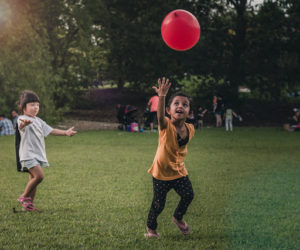There’s a lot of controversy over going back to school this year, and many parents are facing the choice of keeping their children home to do online learning or sending them into the classroom. Both options come with their own challenges and health concerns. Here are some tips on how to keep your kids healthy no matter where their classroom is this year:

Focus on Hygiene
The truth is that good handwashing habits and other basic hygiene practices are important all the time, not just during the current pandemic. Teaching your child to wash their hands after using the bathroom, before eating, and after touching shared items ( such as during gym class or after a trip to the store) can help prevent many nasty bugs. Nobody wants strep, a stomach illness, or the flu any more than they want COVID. Teach your child how to properly wash their hands (with soap for at least 20 seconds.) Singing “Row, Row, Row Your Boat” while handwashing is a great way to help younger kids get the right timing.
Little ones also tend to put their fingers in their mouth, nose and other places you’d rather not think about. If you have a young child at home, you are probably already working on breaking them of this habit. It will take time, but talking to them about how doing those things spreads germs might help. You could also try a product meant for keeping kids from chewing their nails. These non-toxic nail lacquers have a bitter taste that deters most kids from sucking on their fingers. Children who are required to wear a mask at school might need a primer on how to wear it properly, and when to trade it out for a clean one.

Teach Them Good Posture
Another tip that applies every year, proper posture while sitting is essential for your child’s health. Slouching at their desk can cause back and neck problems that might manifest as headaches or trouble with coordination and flexibility.
An easy rule to teach goes like this: Their feet should be flat on the floor, knees bent at a right angle, and arms parallel to the floor. Younger children will pick this up better from a demonstration. Show them how to sit with their head and neck in a neutral position, not bent forward. It is better to lean forward slightly from the hips if they need to get closer to their assignment, rather than bending at the neck or rounding their shoulders. For at-home learners, set up a space that allows them to sit with good posture. Their computer screen should be at eye level, so they don’t strain their neck. Good posture takes practice, and if your kids start young, it’s a habit that will benefit them their whole lives.
Backpacks can also put a strain on your child’s growing spine if not worn correctly. Check to make sure that your child’s backpack is not too heavy and tell them to pack the heaviest items at the bottom of the bag. They should always wear both shoulder straps and be encouraged to use the chest and waist straps to distribute the load evenly. Their backpack should not be wider than their torso or hang more than four inches below the waist. Wearing a backpack incorrectly can cause pain and back problems that can last into adulthood, but it only takes a few minutes to teach backpack safety.

Encourage Physical Activity
Many schools are not providing sports programs, and PE may be limited depending on where you are and what happens with the virus. For children learning at home, the bell won’t ring for recess; it will be up to parents to decide when their child gets to take a break and go outside.
Several studies have shown the benefits of regular physical activity on children’s ability to learn. In addition, time spent being active, and especially time spent outdoors, can relieve stress and boost mood. So how do you make sure your kids get the exercise they need during a COVID school year?
It’s all about scheduling. When your kids get home from school, have a routine that includes a healthy snack, homework, and time to get outside and play. If the weather is bad, encourage your kids to play active video games or do jumping jacks. Even a few minutes of activity has benefits.
Children staying home for school will need to have a scheduled recess, just like they would if they were in class. For children in 3rd grade and younger twenty minutes of learning time, followed by ten minutes of physical activity is usually appropriate (your child’s attention span may be longer or shorter). For older children, a break every hour is healthy. You can send your child outside to play, take them on a walk, or have them do jumping jacks, run in place, or stretch during their breaks. The important thing is that they stand up and get moving.

Help Your Kids Manage Stress
No matter where your child will be learning this year, they will probably have more stress than usual. Learning healthy coping habits is a life skill that will benefit them in adulthood. Talk to your child and encourage them to be open with you about the stresses or fears that they are experiencing. Children of all ages need extra love and attention during stressful times. They also benefit from having a regular schedule that includes times for play and relaxation.
Help your child recognize when they are feeling stressed and what sorts of activities make them feel better. Some kids might need to get outside and kick a ball around, and others might like coloring or another quiet activity. Children learning at home will need to make an extra effort to socialize with friends. You can help by setting up group zooms or other safe interactions.
Healthy meals and a regular sleep schedule will also help lower your child’s stress levels and increase their immunity. Encourage them to eat a variety of fruits and vegetables, and supplement the meals of extra picky eaters with vitamin-fortified foods and drinks. Teach your kids healthy sleep hygiene practices, such as avoiding screens for an hour before bed, having a quiet wind-down period before bedtime, and going to bed at the same time every night. Aim for at least eight hours of sleep; nine is better for growing teenagers.

